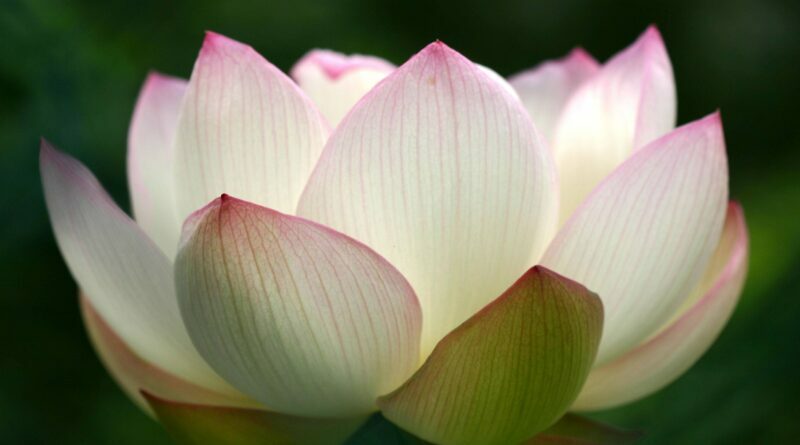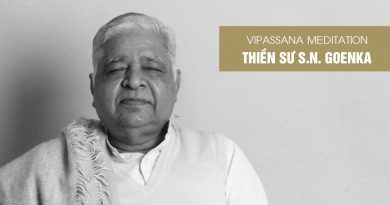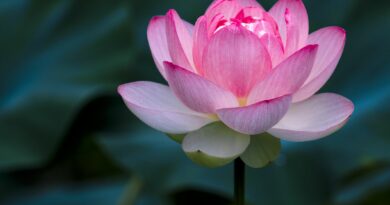How To Discipline The Mind
MAIN CONTENT
(Following discourse was given by Principal Teacher S.N. Goenka in 1998 at Ramabai Amdedkar Girls’ High School, Nasik, Maharashtra)
There are many ways to discipline the mind. India is an ancient land rich in spiritual knowledge where innumerable philosophies and methods for spiritual wisdom have arisen and become established, then have eventually degenerated and passed away. One very simple and popular method of sadhana (meditation practice) prevalent in ancient India, which still continues to be practiced today, is to repeat a word continuously. It can be any word; the goal is to get the mind focused. Just as when a child calms down and then dozes off hearing his mother repeat words of a lullaby, one’s mind too relaxes upon hearing a word repeated.
The seers of this land gave words for repetition like the name of a god, goddess, or saint; anyone that one had developed faith in. Mundane words like clock, clock, clock or such were not given. Some seers have declared that this type of repetitive practice leads to final liberation.
Another ancient sadhana that is still prevalent today is to gaze at an object intently for a while and then close the eyes. Again open the eyes, look at the object, and close the eyes again. After a few days of this practice, one will see the particular object distinctly even with the eyes closed. Therefore, by focusing on an image of any god, deity, or whoever one has faith in, then after closing the eyes that image will start appearing within.
There was yet another method of sadhana – strike a bell or gong sharply, and then focus on the sound waves as they recede in the ether. When the sound stops, strike the gong again and then concentrate on the receding sound waves. There have been many ways taught to concentrate the mind. However, once the mind gets concentrated, then it is crucial to understand and arrive at a further step which is that of purifying the mind.
Final Goal – Freedom from Impurities
Vipassana meditation, yet another ancient technique of India, does not subscribe to these methods of concentration, because the final goal is not merely to bring the mind to a one pointed focus or even to make it free from thoughts. Vipassana’s final goal is to purify the mind of all impurities. For this we need a medium, a tool which will lead us to the point from where the negativities and impurities arise – the root level of the mind – which when experienced enables the impurities, the defilements to dissolve, making one free from them. For this purpose the medium of concentration chosen was a very natural and simple one – one’s own breath.
Breath helps us to concentrate the mind, as well as leads us to the point where the defilements arise. As you walk on the path this will become very clear, as Vipassana is the process of understanding what is happening within. When we concentrate our mind with the aid of one of the many mediums with created images and sounds, as mentioned before, it is indeed helpful to an extent since the surface level of the mind gets still and calm, even free from thoughts. Nevertheless, we still have not reached to the inner recesses of the mind where our behavioral patterns have made deep inroads, and we are unable to break those patterns.
For that, we need a medium that can link us from the surface level to the deepest layers of the mind. Breath is that medium. Therefore, we observe the breath, as it is, as it comes in, as it goes out; just being aware without making it faster, or slower. No effort is made other than to merely observe the breath as it is. It is not a breathing exercise, not pranayama; there is no effort to change it in any way. We just observe with calm detachment, like a person sitting on the banks of a river watching the flow dispassionately. We have no hand in regulating the river’s flow. We just sit and watch it.
We remain focused even though we are simply observing, experiencing the flow of breath. What can be easier than this? Breath remains with us every moment from birth and will be with us until we die, and breath can be observed anytime, anywhere. A very simple, effortless task.
If any of you ever make a resolution to come to a 10-day Vipassana course then you will realise how difficult this seemingly simple task is! You will realise that watching the breath coming in and going out is not easy! You observe not even two breaths and the mind runs away. Then awareness arises and you will see that the mind is not with the breath. The mind simply does not remain on the given task. This disturbs new meditators and they run complaining to their guide that the mind does not stay focused. The guide of course reassures them saying there is nothing to worry about as this is part of the process. Then some meditators may start getting angry at their own minds, “I can’t watch even a simple breath!” Their anger only generates further agitation – whether it is directed towards themselves or others. One must just accept the reality. This moment’s reality is that the mind has wandered off. Now start again. Bring the attention back to the breath. Again, it will wander off. Again, bring it back.
You will understand many secrets about yourself as you continue to work in this way. This is the aim of the practice. If you merely remain focused on the outer world’s reality as you have been doing, then you will not know your own reality, the truth as it exists within. Sadly the entire life is then lost in delusion. A saint of India had this to say –
“The outer inner reality is but one, this knowledge was revealed by the guru.”
The inner and outer reality is the same, said Sat Guru, a true master. Nature’s Law that works outside is the one that works within too. However, Nanak said,
“Until you know your own self, the mist of delusion does not disappear.”
Nanak does not speak from merely having read books, or from having heard discourses or even from contemplation. Having experienced the truth first hand he said that without knowing one’s self, delusion will not dissolve, and our lives will be spent in illusions.
It is vital to know one’s self in order to realise how the defilements arise within, how they multiply and then overpower us. To understand this is the reason we need to go deep within ourselves.
Observing with Awareness
How does this phenomenon work and how do we come out of it? The realities will start becoming apparent as we observe the breath. If the mind wanders, where does it go? We cannot keep track of all the places, situations, and desires which the mind wanders to. However, if we observe carefully we will notice that there are only two areas it runs towards – either the past; dwelling in what has happened or did not happen – or the future; dwelling in what will happen or will not happen, what one will or will not do, etc.
Thus, the mind keeps rolling in the past or the future. Now we have started understanding it a little. The mind does not live in the present, but it must live in the present. How can you live in the past? The moment that has passed is gone forever. The entire wealth of the world cannot bring it back. Moreover, the future moment can be experienced and lived in only once it becomes the present. Therefore, we have to live in the present.
Unfortunately, the nature of the mind is such that it only wants to wander in the past or the future. Now we have to teach it to remain in the present, and the reality of this present moment is that the breath is coming in and going out. We are not imagining it. We experience it – the incoming and outgoing breath – and we learn to remain with the reality of this. However, due to the old habit pattern the mind runs again and again into thoughts of the past or the future.
The next thing meditators examine is what kind of thoughts arise in the mind when it goes in the past or the future. Oh, the thoughts are countless! How can we keep a record of them? Whether our mind wanders in the past or the future, it loves to dwell in these thoughts. The mind may create dreams of the future and roll in them, or it may wander in an unpleasant memory of the past, thinking this event was so unpleasant and it must not happen again. Now we begin to observe like a researcher, objectively, analytically. Another aspect that one sees is that the mind has started reacting. One wants the pleasant thoughts to continue, to multiply; “I want them” becomes the refrain. Moreover, when unpleasant thoughts occur, then the mind reacts with “I don’t want them.” This is the nature of the mind in which it is deeply caught. One begins to see this as a universal truth.
This refrain of “I want, I want” was called raga or craving, attachment in the ancient language of India. Raga towards that which is pleasant and dosa or aversion, “I don’t want”, towards that which is unpleasant. Thoughts continue to flow every moment. If they are pleasant then I give rise to craving, and if they are unpleasant then I give rise to aversion. This habit pattern has bound us and it results in agitation and anxiety. We can now experience the source of our agitation, the defilements within.
When someone comes to a ten-day Vipassana camp, after two to three days go by, one starts realising some such basic truths. He or she experiences that as soon as a defilement arises in the mind, be it jealousy, anger or aversion, the breath loses its natural rhythm and instantly becomes fast or heavy. Then as soon as the defilement dissolves, it returns to its normal rhythm. We never knew that the breath was so deeply linked to the defilements in our minds. This truth was forgotten as we had lost the ancient knowledge of Vipassana.
Slowly we begin to understand why the sages, rishis, and gurus of yore taught the practice of pure breath. The goal was to purify the mind and become free from all defilements. For that, we have to reach the very core within where these defilements arise, and where the mind reacts, reaction being its nature. Only then can we work to eradicate them. It is easy to cleanse the mind at the surface level. If we shift it’s focus to some positive thought then the surface of the mind, at least, will turn positive. However, we have to change this habit of reaction at the very root level. This truth becomes clear as one works with the breath.
As we move deeper into ourselves, further secrets about nature will reveal themselves to us. We begin to understand the entire path to ultimate reality very scientifically, as we explore the interaction of mind and matter at the experiential level.
Proceeding further, one understands that as defilements arise in the mind, and the breath loses its natural flow, some sensations, some changes begin on the body at the physical level. If there is anger, one sees that the body starts becoming hot and tenses up, and the pulse increases. This happens to everyone, whether one is a Hindu, Muslim, Buddhist, Indian, Burmese, American, whoever. It is the law of the nature that whenever a defilement arises in the mind two things start happening simultaneously. One, the breath changes its normal rhythm and two, some pulsation, some vibration arises at the physical level that is deeply related to this defilement. The entire teaching is to enable us to reach the level where defilements arise, observe them with the aid of the breath and the physical sensations, and learn how to remove them. However, first we must reach this level.
Breaking Barriers
What we call the subconscious part of the mind is actually not subconscious, in reality it is very conscious, and the surface mind, which was called paritta citta (limited mind) in the language of ancient India, is a very small part of the mind. When Dhamma is heard, read or contemplated, it influences this surface level. We may be able to purify this part of the mind, even feel calm tranquility for a while, but the mind that remains submerged deeply within continues to generate defilements, as there is a strong barrier between these two parts that remains unbroken.
The masters and sages of our country discovered the knowledge of how to break these barriers, so that the entire mind would become aware and conscious and would know when a defilement had arisen from its very depths. And would also understand that as a result of these defilements some sensations arise at the bodily level.
When one is unaware and unconscious, one looks outside for the cause of an emotion that may have arisen. If anger arises, the person will look for the cause outside. Nevertheless, the external causes come and go. Someone insults me and goes away. However, the hurt does not end there. I keep mulling it over keeping this anger alive for hours on end. With this, I am only making myself agitated. The person who insulted me in order to hurt me did it once. However, I am determined to remain hurt and agitated for a long time. We say at times that someone was so rude to me that I will not forget this insult for the rest of my life. This is foolish, as this will only keep us in agitation for the entire life.
Now that I know the law of Nature, why should I become agitated if someone has insulted me? He may be in some misery of his own and so abuses me, but why should I become miserable along with him? Let him deal with his own misery. If I can help him I will, but now at least I will not become miserable and angry like him.
This teaching describes what should be done if a situation arises where someone may insult you. You do not sit idle like a stone thinking, “I am a meditator and will not say anything even if someone knocks me down”. If the person does not understand gentle responses and the situation demands firmness, then you will behave firmly. First, you will check to see that there is no anger or animosity within you. If there is, then first you need to improve yourself. Until then your response will likely be faulty which will help neither him nor you.
With these teachings and with practice our responses to situations in life improve. As soon as an event takes place, we look within, even if only for a few seconds, and see that as soon as anger arises, sensations follow, the breath becomes hard, and even as we are watching it, it calms down. Now whatever action we take will only be right and good for us and for others, as it comes from a conscious mind.
The Art of Living
Indeed Dhamma teaches us the art of living; how to live a life filled with joy and peace. From among all the tools that help us to go within, we take the help of the breath to reach the stage from where we can see, where we can experience the interaction between mind and matter. We then observe the effects that the mind and body interactions have over each other; how the defilements arise and multiply until they overpower us and we lose our senses. The Dhamma teachings enable us to observe within and understand ourselves in order to come out of misery.
As soon as one knows oneself the suffering lessens, the fearful burning lessens. Life becomes peaceful and happy. This cannot be learned merely by discourses, reading scriptures or contemplation. It has to be experienced and practiced – this is Vipassana. To know the truth within at the experiential level and to purify oneself for one’s own welfare – this is Dhamma, the ancient wisdom of India.
We hope that those who came for today’s Dhamma gathering will not take these words as mere intellectual entertainment. May you all be inspired to take a step towards self-exploration and see the truth within, to become free of defilements, for your own welfare as well as the welfare of others.
Source: https://www.vridhamma.org





